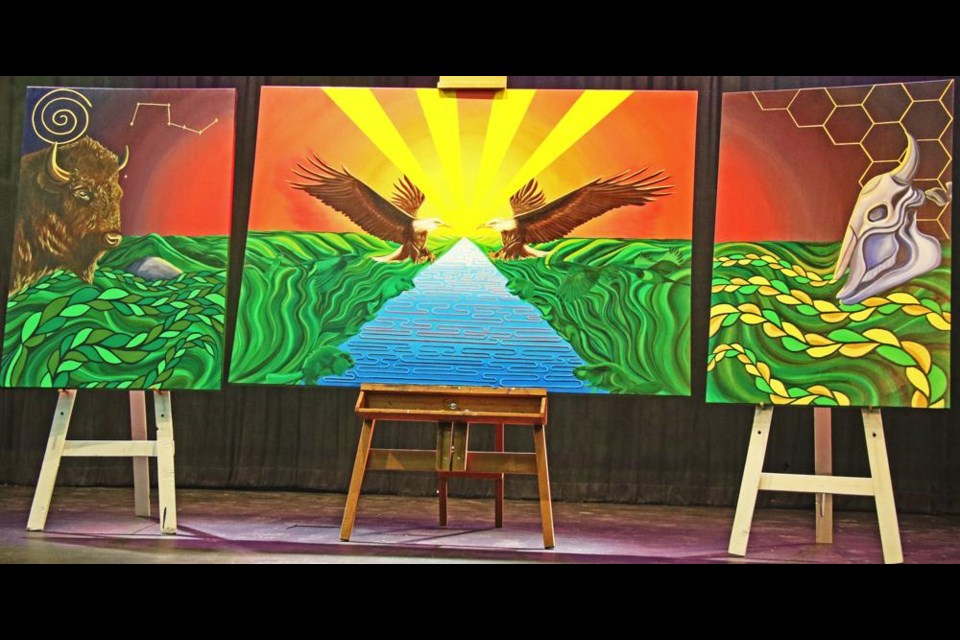WEYBURN – The Weyburn Comprehensive School commissioned a First Nations artist to develop a canvas Treaty 4 mural, which has now been installed in the main entry of the school.
The mural, created by Indigenous artist Brianna LaPlante of Fishing Lake First Nation, was unveiled at a special assembly ceremony on Friday afternoon in the Cugnet Centre, which included a smudging ceremony. LaPlante explained the journey to create the mural as well as some of the symbolism depicted in it, and the smudging was carried out by Amos McArthur, the community education liaison from Arcola School.
The student assembly was told the idea for the mural came from the SRC in the spring of 2022, as they wanted to have a legacy project for the school. They applied for a Horizons grant which could be put towards leadership or legacy projects in the school, and were successful in getting a grant.
After some discussion amongst SRC members, they decided their legacy project would be a Treaty 4 art piece, designed and created by an Indigenous artist.
Raquel Oberkirsch, the First Nations education coordinator for Southeast Cornerstone School Division, put them in touch with LaPlante, and she came and spent time with them discussing their ideas, including holding a paint night with SRC and staff members.
She took the ideas from those paintings, and combined them with her own vision and over a period of months, created the mural unveiled on Friday.
“We are so thankful Bri allowed us to be a part of the creative process in this way. A piece of each of us will be part of this incredible legacy,” said the co-chairs of the SRC.
Speaking about that creative process, LaPlante explained she took aspects of the imagery in the Treaty 4 flag, but focused more on the connection with the land than with the treaty.
“We got started with the paint night. I was honoured to lead a paint night after a presentation to the students. Working with the community I wanted to show you guys what I made from the heart,” she said.
“The land doesn’t need to live with us, but we need to live with the land in order to function, in order to have fruitful lives in the community. I wanted to create a reciprocal piece, one that’s symmetrically balanced to represent the duality of life and the environment, and how we’re kind of moving forward in our relationship to the land,” she explained.
In the left-hand panel, she had a buffalo and the Big Dipper constellation in the sky above it. On the right hand panel was a buffalo skull, and braids interwoven with the grass.
“The braids are a very common motif in my work. The three strands are mind, heart and spirit. It’s something I love to include into my artwork. The braid is the physical product of combining those three things, and I consider my artwork as emulating that process,” she said.
The buffalo was included because, while they are not the vital part of their lives now as they once were, “they will always be there.”
The Big Dipper is important, she added, because no matter where the constellation is in the sky, “it always points north. That was an important symbol to include, because when you look up in the sky, you will have direction anywhere you are in life.”
In the central panel, she painted two eagles facing each other with a river in between, with a sun on the horizon behind them. LaPlante said the viewer can decide if it’s a sunrise or sunset. The scene shows how everything in nature is in sync with each other, and “it reminds us to think about how we can be more in sync within the Treaty 4 lands, within our communities and within our schools.”
The balance of the two eagles is something that represents the school, as their official mascot is the eagle.
“That’s something I feel I share with you guys. It represents duality, even when we’re not side by side or together,” said LaPlante. “I just want to encourage you all to shine. … I really made this piece from my heart. I really want this to be used in the future as a teaching tool.”
McArthur spoke briefly before conducting a smudge ceremony over the painting. He also invited any of the students to come up and do a smudge after the unveiling ceremony was over.
Smudging is a tradition common to many First Nations people, which involves the burning of one or more sacred plants gathered from the earth. The most common sacred plants used in smudges are tobacco, sweetgrass, cedar and sage.
“To see this artwork, it shows me a part of who we are,” he said, noting he never had anything like this in any school he attended while growing up. “This is for you students. It’s not for me, it’s for you. My sister Bri put her heart into it.”
The mural was installed afterward above the main doors of Colleen Weimer Hall.





